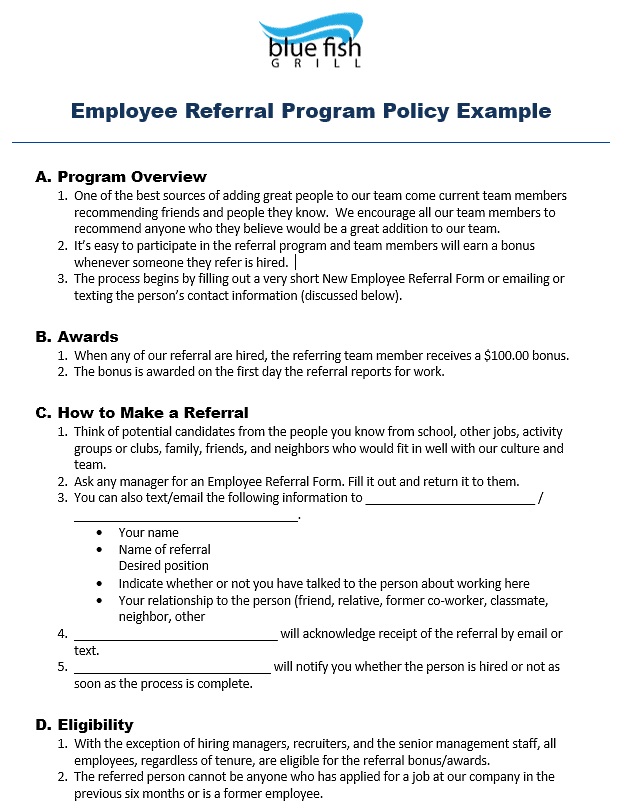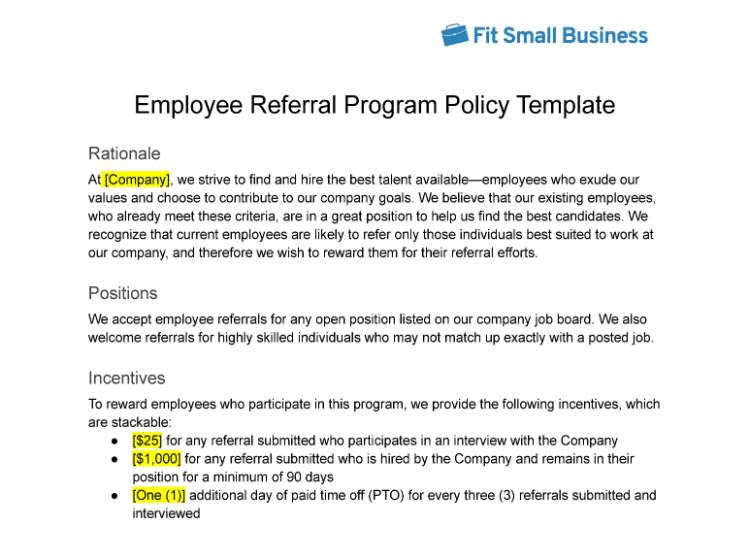According to Forbes, 88% of employers cite employee referrals as their leading source of superior job candidates. This method has proven crucial to human resources departments aiming to fine-tune their recruitment process.
Also, the Wharton faculty reports that a referred customer’s average value is 16% higher (at minimum) than a non-referred customer.
Crafting a strategically-inclined policy for your employee referral program (whether that’s for talent acquisition or bringing in new customers) will help harness the benefits discussed above.
Below, we’ll explore how to create an employee referral policy.
What is an employee referral policy?
An employee referral policy establishes clear expectations and criteria for your employee referral bonus program. It communicates who’s eligible to refer and how to earn the associated rewards.
The aim is to have a defined, well-honed system to encourage employees to leverage peer networks. By doing so, eligible team members can benefit your company by:
- Finding high-level candidates for open positions in your business.
- Suggesting products and services to family members, friends, and peers.
- Or, both.
The rewards mentioned above are the defined incentives if your eligible employees help recruit a hire or make a sale.
Employee referral program policy: When employees refer job candidates
This guide’s intro addressed the high employee retention rates when candidates are referred.
One reason referred employees stay longer is their ability to start the onboarding process earlier. This allows them to hit the ground running.
Such candidates can start 29 days after they’ve been referred. Non-referred applicants take closer to 40 days (through job boards) and 55 days (through job postings on career sites like LinkedIn), meaning referrals reduce time-to-hire.
Below, we’ll delve into the specific components required for an employee job referral policy:
Who is eligible to refer?
Clarifying who’s eligible for your referral policy is critical to the success of your program.
Confusion could create tension if someone makes a referral only to realize they don’t qualify for rewards. Thus, morale could take a hit.
For instance, will your employee job referral policy only extend to full-time team members? Or can part-time staff and contractors participate?
Hiring managers, recruitment/hiring team members, and HR department members typically aren’t eligible for rewards. There’s often too much of a conflict of interest.
The same notion applies to managers hiring someone directly reporting to them. They aren’t eligible to earn rewards for referring direct reports. But if the manager refers suitable candidates for roles in different departments, they’re usually still able to collect a reward.
What candidates are eligible to be referred for rewards?
Companies must also avoid conflicts with the referred candidates. So, apply specific requirements to those being referred.
Some typical recruitment rules for an employee referral program are as follows:
- A referred candidate can’t be a previous employee. Nor can they be a current applicant. Also, they can’t have applied within the past twelve months.
- A referred candidate can’t be an employee’s family member.
- Someone can’t have already referred a candidate within a specific timeframe. Generally, the first referrer–within a designated period–is attached to the candidate. They’ll earn the rewards if/when the candidate is hired.
- A contractor or temporary employee can’t be referred for rewards.
Who should employees refer?
Describe the ideal employee you want applying for available job openings. Your company (and human resources team) has a standard to uphold for hiring the most suitable and qualified candidates.
Sorting through unqualified candidates can disrupt productivity.Therefore, on top of defining what you seek in an employee, clearly define a referral candidate that wouldn’t make the cut.
When are rewards earned?
Clarify all available rewards (e.g., cash bonuses and gift certificates) for employee referrals. Outline how and when they’re earned.
An approach many companies use is giving a single reward once an employee is hired.
Alternatively, a referring employee can earn multiple rewards as their referral travels through the hiring process. If you choose this approach:
- Is there a smaller reward when the candidate applies, and/or when they are approved for an interview?
- Does the main reward for hiring get paid out immediately when the referred candidate gets hired? Or is it paid out 30, 60, or 90 days after hire, assuming the referred employee is still with your company?
What are the other reward rules?
Being specific with your employee referral program policy for new hires will ensure clarity and increase engagement. Leave no stone unturned in providing guidelines.
For instance, what will you do for employees who continually refer more new hires?
After all, some team members might excel in recruitment strategy, and you should harness those gifts. In this instance, many companies will increase the reward value (in a tiered format) in line with the number of successfully referred individuals.
What happens if someone gets referred by multiple current employees in your employee referral program? In most instances, the original referrer receives the incentives and rewards.
Also, will you cap rewards-eligible referrals, or can your people create an endless stream of new employee referrals?
Can referrers maintain their eligibility for rewards if their friend applies for a position different from the one they were originally recommended? Most experts suggest that they should.
How can employees refer candidates?
Add the following instructions to your job candidate referral policy:
- Explain how employees can use their referral link and form to make referrals.
- Describe how your people can track referral statuses. Utilize referral software to streamline this process.
Employee referral program policy: When existing employees refer customers
A policy for a customer-based employee referral program could lay a foundation for exponential company growth. To this point, referral marketing yields three to five times higher conversion rates than other channels. Furthermore, referred customers offer brands a 25% higher profit margin.
Let’s delve into sections and content required for your customer-based employee referral program policy.
Who is eligible to refer?
Can part-time employees and contractors partake in your customer-focused employee referral program? Or will it only be available for full-time workers?
Do you wish to provide ambassador training? And must employees get trained to be ambassadors before they can get rewards? Or are any employees eligible without training?
Allowing untrained team members to refer customers is entirely feasible (and helpful) since they’re still encouraging business growth. However, the big-picture success of this program could skyrocket if you go the extra mile and offer training.
Who should employees refer as customers?
You’ll bolster your employer brand by giving your people every chance to succeed in your employee referral program.
A highly impactful way to help is by providing a profile of your target customer (or the person most likely to be interested in your products). A clear illustration of your ideal consumer will provide a template for a successful employee referral.
Who is eligible to be referred for rewards?
What type of customer can your employees refer through your program? Can it only be friends who’ve never purchased with your company?
On the other hand, say you sell subscriptions–are inactive users eligible as referrals even though they’ve used your service in the past? When you further incentivize this type of referral, you prioritize getting lapsed customers back on board, a substantial difference-maker for any company.
When are rewards earned?
Describe the rewards available for referrals and when they’re earned.
In most cases, the referred customer must purchase before the rewards are doled out. However, lengthier sales processes, such as those common for B2B companies, could mean paying out a smaller reward for qualified leads along with a larger one for a sale.
Tell your employees how to receive their reward once they’ve earned it, whether that’s a cash bonus, tickets to an event, gift card to a favorite business, or anything else. Your HR team could be responsible for handling rewards.
What are the other reward rules?
Establish as many rules as possible to ensure your employees have the appropriate guidance for your customer-facing referral policy. Try to craft the rules to benefit your company most.
Will you use a tiered format for your referral program? In other words, will you increase the value of the rewards when an employee refers more customers?
Similarly, will the first or most recent referrer receive the reward if multiple employees refer a customer?
Is there a limit on how many reward-eligible referrals can be made? Or will you allow unlimited referrals?
How can employees refer customers?
Ease of use means everything when encouraging full-throttled employee engagement in a customer-facing referral program. Concise, simplified instructions on referring customers combined with straightforward referral processes will foster enthusiasm amongst your team.
Break down every detail on how employees can make referrals. Describe how they’ll use their referral link and employee referral form.
Incorporate referral software to enable seamless referral status tracking. This will make it easier for employees to track their referrals and even easier for you to provide instructions.
Wrapping up
An employee referral program (for new hires and customers) can help take your company to the next level. That said, making the extra effort to foster employee engagement is 100% necessary. Such a policy establishes all the essential rules while limiting any confusing gray areas that could lead to strife.
While these programs can be simplified, they also present challenges. You can offset any potential snafus by learning the ins and outs of related topics, like the specifics of employee referral bonuses. Or, you can delve into more granular details about crafting an employee referral program.
Also, don’t hesitate to schedule a demo if you wish to learn more!





